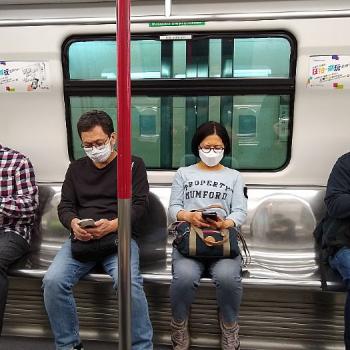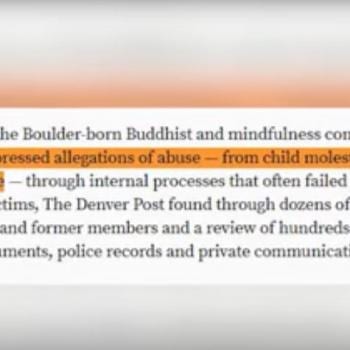For Sunday, the 27th of May, 2012
Yesterday the Japan Times reported that monks there are moving out of the temples and into their communities. Discussing the background of some schools of Buddhism in Japan, the Times reports:
While Zen and other Buddhist sects prioritize training and practice, including meditation, as necessary for reaching salvation, Jodo Shu adherents believe that “the absolute power of Amida Buddha, not our own strength, will bring us to the Pure Land,” Kajita says.
Honen was later exiled to Shikoku and the grounds were abandoned for several centuries until 1680, when Honen-in was established at the site by priests from Chion-in Temple, Jodo Shu’s temple headquarters. Honen-in continued as a Jodo Shu affiliate but is now operated as an independent family-run temple.
The article concludes:
Although Japanese Buddhist monks are not noted for social or political activism, [temple leader Shoshin] Kajita has recently begun taking on a more visible community role. Over the past few years he organized a series of discussion meetings with local citizen groups — both supporters and opponents — of a plan to allow a Kansai-based firm to build an aquarium in a Kyoto municipal park…
“Religion should concern itself with people’s problems, and monks shouldn’t simply stay in the temple and chant,” he says. “Buddhism is not just something we practice in solitude, under ideal conditions. We all need to consider our basic selfishness and come up with new ideas to achieve peace and environmental health.”
The many twists and turns of Buddhism’s development in Japan are an area I have only touched here and there in my academics. Most recently, I looked into the Bodhidharma or Daruma Zen sect, which seemed to cast off all clear moral direction, focusing not on being in society or even meditation, but simply on nonduality and philosophy. As I wrote for the upcoming UN Day of Vesak / IABU Conference, (paper here), the abandonment of basic ethics seems to have been their downfall.
While a lot has changed in the last 35 years, I still know of no better short video for tracing the outlines of Buddhism in Japan than this:
http://www.youtube.com/watch?v=G6KyQIo9Q7M
Meanwhile, David Mason of Kyung Hee University writes an impassioned defense of Korean Buddhism (in relation to the recent Jogye Gambling Monks scandal there). He writes:
I certainly do agree that this is an internal matter for the religious order involved to deal with according to their own rules and customs, and that under the successful doctrine of religious freedom maintained by Korea since its founding, the government has no justification for any involvement in it and is wise to be refraining.
Of course, if any laws were broken in any of this then authorities should respond to it just as they do for any other citizen, it should be needless to say.
Within the past half-century or so the Jogye Order of Korean Buddhism has been amazingly successful in reviving the true flavor of its ancient spiritual traditions centered on Seon, and in globalizing itself in all kinds of outreach.
As a result, Korean Buddhism now enjoys a very high reputation around the world, and I do not expect that the manufactured outrage over this kind of minor incident will cause it any significant or lasting damage.
So long as the order is transparent and forthcoming in its response and nothing like this comes up again (too soon), I think he’s right. The uncertainty for now is whether this is just a few bad monks, or signs of systematic laxity in ethics.
Finally, speaking of ethics, the story at Diamond Mountain has been updated over at Elephant Journal and has reached the pages of the Huffington Post. This is the first major news outlet to cover the story that I have seen, but hopefully more will come. More light is still needed in this bizarre case which unfortunately led to the death of one man.
~
In health news, Tom, over at Sacramento Homeless, writes about the “bordering on criminal” unhealthy food that is distributed to the homeless community in Sacramento. He breaks down a typical day’s lunch here:
The lunch had 1066 calories, which is approximately half what you should eat in a day. There were 51 grams of fat, which is 79% of the daily allowance. There were 17 grams of saturated fat, which is 86% of the daily allowance.
The article might have passed me by if I hadn’t then read that 1 in 3 homeless are obese. Hungry and obese. Obese due to the excess of processed calories mixed with sodium, sugar, and saturated fat. Hungry because even when there is plenty, these foods are not very filling.
 There is an interesting parallel, also, between the sugary, cheap foods given to the homeless (and the rest of us but primarily the less well-off) and the cigarettes given to G.I.s in Korea and Vietnam in the ’60s and ’70s. In both cases they were made cheap and given to people who didn’t have much choice. And in both cases they created (and are creating in the former case) life-long addicts who are not only physically less healthy but suffer psychological problems as well.
There is an interesting parallel, also, between the sugary, cheap foods given to the homeless (and the rest of us but primarily the less well-off) and the cigarettes given to G.I.s in Korea and Vietnam in the ’60s and ’70s. In both cases they were made cheap and given to people who didn’t have much choice. And in both cases they created (and are creating in the former case) life-long addicts who are not only physically less healthy but suffer psychological problems as well.
Only today the doctors aren’t posing with cigarettes as much as scalpels, claiming the ease and benefits of removing parts of your digestive tract or cutting out fists full of fat.











